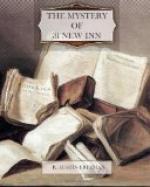As this, however, was apparently not in dispute, it furnished no new information. Thorndyke’s object—for I felt certain that he had something definite in his mind—must be to test something apart from the genuineness of the signatures. But what could that something be? I dared not ask him, for questions of that kind were anathema, so there was nothing for it but to lie low and see what he would do with the photographs.
The whole series was finished on the fourth morning after my adventure at Sloane Square, and the pack of cards was duly delivered by Polton when he brought in the breakfast tray. Thorndyke took up the pack somewhat with the air of a whist player, and, as he ran through them, I noticed that the number had increased from twenty-three to twenty-four.
“The additional one,” Thorndyke explained, “is the signature to the first will, which was in Marchmont’s possession. I have added it to the collection as it carries us back to an earlier date. The signature of the second will presumably resembles those of the cheques drawn about the same date. But that is not material, or, if it should become so, we could claim to examine the second will.”
He laid the cards out on the table in the order of their dates and slowly ran his eye down the series. I watched him closely and ventured presently to ask:
“Do you agree with Mr. Britton as to the general identity of character in the whole set of signatures?”
“Yes,” he replied. “I should certainly have put them down as being all the signatures of one person. The variations are very slight. The later signatures are a little stiffer, a little more shaky and indistinct, and the B’s and k’s are both appreciably different from those in the earlier ones. But there is another fact which emerges when the whole series is seen together, and it is so striking and significant a fact, that I am astonished at its not having been remarked on by Mr. Britton.”
“Indeed!” said I, stooping to examine the photographs with fresh interest; “what is that?”
“It is a very simple fact and very obvious, but yet, as I have said, very significant. Look carefully at number one, which is the signature of the first will, dated three years ago, and compare it with number three, dated the eighteenth of September last year.”
“They look to me identical,” said I, after a careful comparison.
“So they do to me,” said Thorndyke. “Neither of them shows the change that occurred later. But if you look at number two, dated the sixteenth of September, you will see that it is in the later style. So is number four, dated the twenty-third of September; but numbers five and six, both at the beginning of October, are in the earlier style, like the signature of the will. Thereafter all the signatures are in the new style; but, if you compare number two, dated the sixteenth of September with number twenty-four, dated the fourteenth of March of this year—the day of Jeffrey’s death—you see that they exhibit no difference. Both are in the ‘later style,’ but the last shows no greater change than the first. Don’t you consider these facts very striking and significant?”




